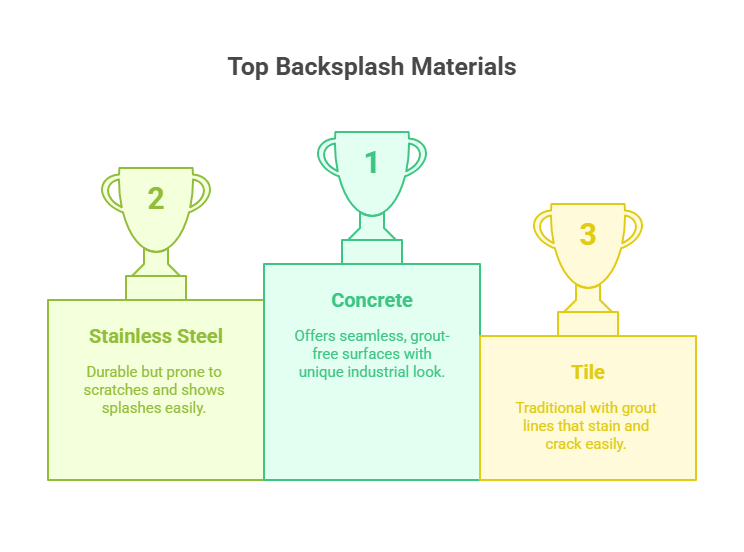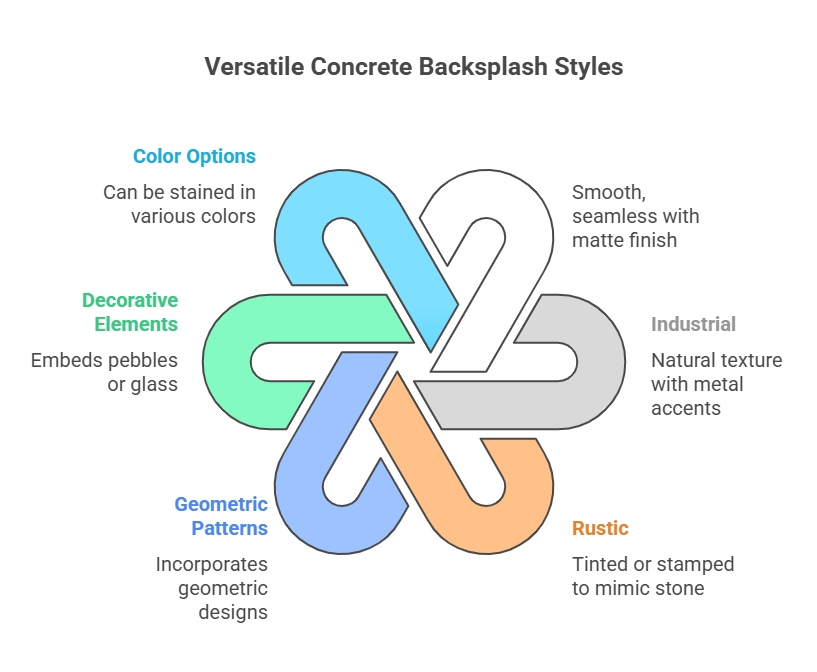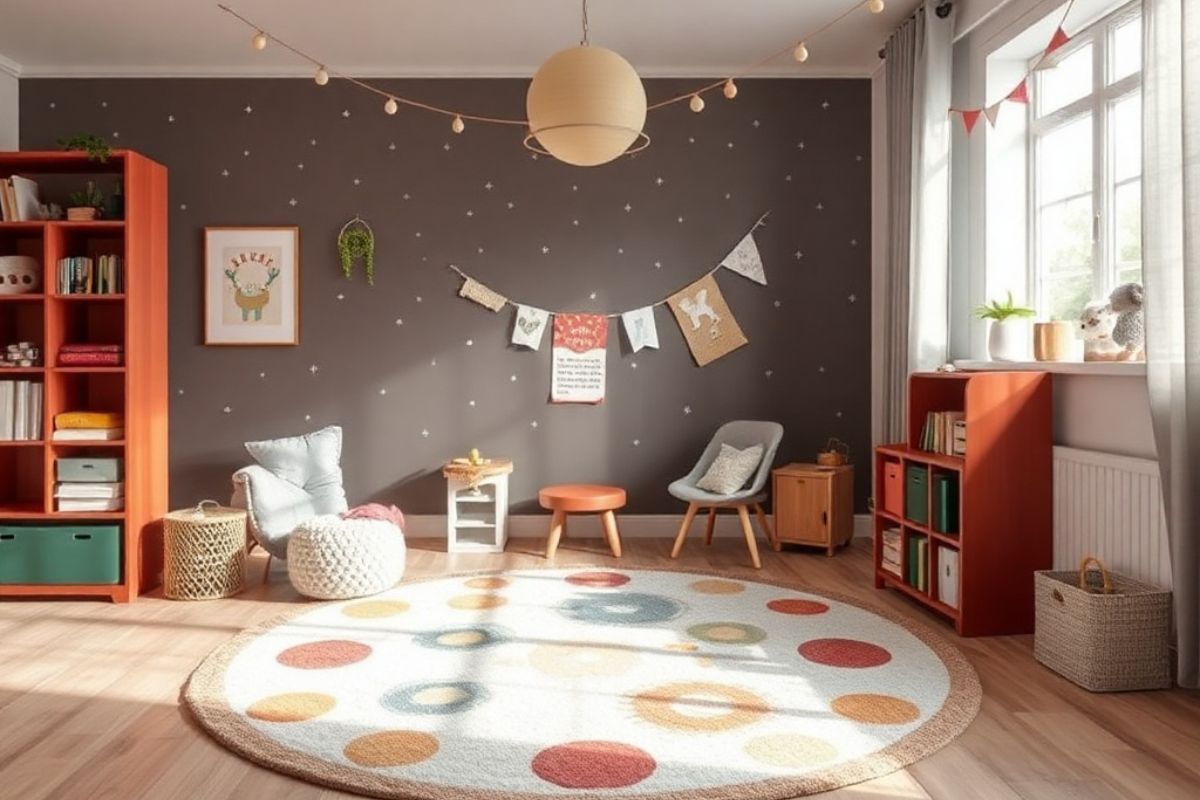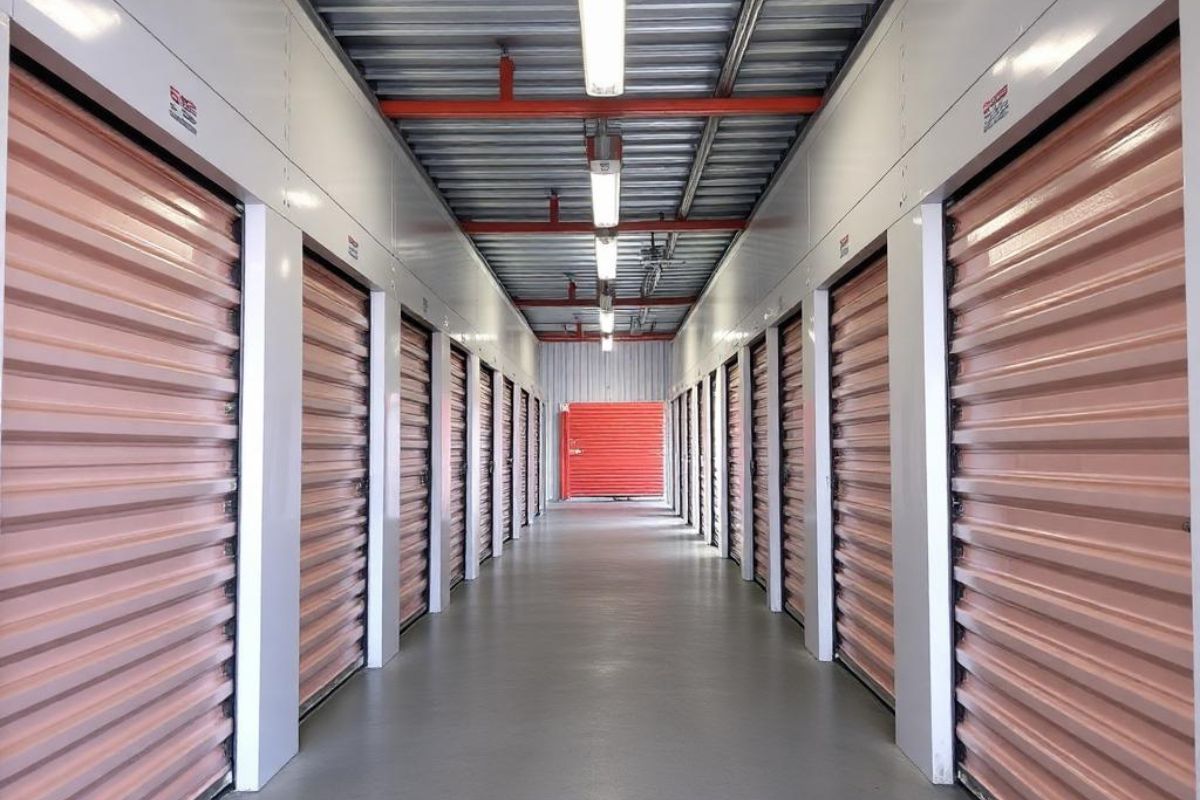Concrete Kitchen Backsplash: Modern Industrial Design That Lasts

A concrete kitchen backsplash gives your kitchen a modern, industrial vibe with unbeatable durability. You’ll get a surface that resists heat, moisture, and stains—perfect for busy cooking spaces. With colors, textures, and finishes you can customize, it suits any style from sleek minimalism to bold patterns. Just remember, professional installation guarantees a lasting, seamless look and annual sealing keeps it looking fresh. Pairing with the right cabinets and lighting takes your design even further—find out how to create your ideal space next.
- Concrete backsplashes offer outstanding durability, resisting heat, moisture, and stains when properly sealed for a long-lasting kitchen solution.
- Their modern industrial aesthetic features customizable colors, textures, and edge profiles to fit diverse kitchen styles and preferences.
- Seamless concrete panels or geometric tile patterns create sleek, minimalist looks or bold, unique statement walls.
- Concrete pairs well with materials like stainless steel, wood, and quartz, enhancing contrast and visual interest in modern kitchens.
- Maintenance is simple with daily cleaning and annual resealing, ensuring both beauty and functionality for years.
What Makes Concrete an Ideal Backsplash Material
Although you might think of concrete as just a flooring or outdoor material, it’s actually a smart option for kitchen backsplashes. Concrete stands out because it’s incredibly durable, handling heat, moisture, and frequent cleaning without showing wear. You won’t have to worry about stains from cooking splashes, since sealed concrete resists most spills and is easy to wipe down. Its solid construction means it won’t chip or crack easily, even in a busy kitchen.
Concrete is also non-combustible, making it safe behind stoves or cooktops. Plus, it’s a hygienic choice, since it doesn’t harbor mold or bacteria when properly sealed. If you want a long-lasting, low-maintenance surface that stands up to daily use, concrete offers practical benefits beyond its modern look.
Design Options for Concrete Kitchen Backsplashes
If you’re considering concrete for your kitchen backsplash, you’ll find it’s surprisingly versatile when it comes to design. You can opt for sleek, seamless panels that create a modern, minimalist look. For a more distinctive style, try geometric sections or concrete tiles arranged in unique patterns. Concrete also pairs well with materials like stainless steel, wood, or glass, letting you create striking contrasts or a cohesive industrial theme. You might want a subtle, understated backdrop or a bold, sculptural feature—concrete adapts to both. Consider integrating built-in ledges or niches for added function and interest. Whether your kitchen is open and airy or cozy and compact, concrete backsplashes suit a range of layouts and cabinet styles, helping you achieve your design vision.
Customization: Color, Texture, and Finish Choices
With dozens of ways to customize concrete, you can easily tailor your backsplash to suit your kitchen’s style. Choose from a wide spectrum of colors—integral pigments let you go bold or keep it subtle, while stains and dyes add depth or create a weathered effect. You’re not limited to one shade; concrete lets you blend tones for a unique look. For texture, you can opt for smooth, polished surfaces or embrace tactile finishes like troweled, sanded, or even exposed aggregate for extra character. Finishes also matter: glossy sealants enhance color and reflect light, while matte or satin options offer understated elegance. Don’t forget about edge profiles and inlays for extra personalization. With these options, your concrete backsplash becomes a true one-of-a-kind feature.
Comparing Concrete to Tile and Other Backsplash Materials
Concrete offers customization options that far exceed what you’ll find with traditional backsplash materials, but it’s also important to weigh how concrete stacks up against popular choices like tile, glass, and stainless steel. If you want a seamless, grout-free surface, concrete’s the clear winner. You get fewer joints, which means less cleaning and less risk of mold. Tiles can crack and their grout lines stain easily, while glass backsplashes show fingerprints and smudges quickly. Stainless steel is durable but scratches easily and shows every splash. Concrete, when sealed properly, resists stains and heat quite well. It also gives you a unique, industrial look that’s hard to replicate. If you’re after a blend of style, durability, and easy maintenance, concrete stands out from the rest.

Installation Process: What to Expect
Curious about what goes into installing a concrete kitchen backsplash? First, you’ll need to measure your wall area and prep the surface—remove any grease or debris so the concrete adheres well. Next, a professional typically creates a sturdy template or form directly on your wall. They’ll mix the concrete, pour or apply it, and then smooth it for a consistent finish. Sometimes, they’ll embed reinforcement mesh for added strength. You’ll need to wait while the concrete cures, which can take several days. Once it’s dry, your installer will seal the surface to protect it from stains and moisture. Expect some noise, dust, and limited access to your kitchen during installation, but the results—durable and striking—are well worth the brief inconvenience.
Maintenance and Cleaning Tips
Although concrete backsplashes are highly durable, they do require a bit of regular care to keep them looking their best. Wipe the surface daily with a soft cloth or sponge and mild dish soap—avoid harsh chemicals or abrasive pads, as these can damage the sealant. Immediately clean up spills, especially acidic substances like lemon juice or vinegar, to prevent stains. Every few months, check for any cracks or chips; repair them promptly to stop moisture from seeping in. Reseal your backsplash once a year to maintain its resistance to stains and water. If you notice dullness or buildup, a mixture of baking soda and water works well for gentle scrubbing. With consistent attention, you’ll preserve both the appearance and performance of your concrete backsplash.
Pros and Cons of Using Concrete in the Kitchen
When you’re weighing materials for a kitchen backsplash, it’s important to know how concrete compares to other options. Concrete stands out for its modern, industrial look and customizable finish. You can tint, texture, or shape it to fit your design vision. It’s highly durable, resisting heat and scratches better than many traditional materials. However, concrete is porous, so you’ll need to seal it regularly to prevent stains and moisture damage. It can develop hairline cracks over time with natural settling, although these usually don’t affect performance. The surface feels cool and hard, which some people find appealing but others may consider too stark. Concrete backsplashes are heavy, so you’ll want to guarantee proper wall support during installation. Consider these factors before deciding.
.jpg)
Cost Considerations and Budgeting
While concrete offers unique style and durability, it is essential to factor in both material and installation costs before committing to a concrete kitchen backsplash. Concrete itself is relatively affordable, but custom fabrication, reinforcement, sealing, and finishing can quickly add to the price. You’ll also need to budget for professional labor, as installing concrete backsplashes requires skill to guarantee a smooth, crack-free result.
Expect to pay more than standard tile or laminate options, especially if you choose custom colors, textures, or integrated features. Don’t forget long-term maintenance costs—resealing protects your investment but adds to the lifetime expense. Get multiple quotes, clarify what’s included, and set aside a contingency fund for unexpected issues. Careful planning helps you stay on budget and avoid surprises.
Inspiring Concrete Backsplash Ideas for Every Style
Because concrete is so versatile, you can tailor a backsplash to match any kitchen style—whether you prefer sleek modern lines, rustic charm, or industrial edge. For a minimalist look, opt for smooth, seamless concrete with a matte finish. If you love an industrial vibe, expose the natural texture and pair it with metal accents. Prefer a rustic touch? Try tinted or stamped concrete that mimics stone or brick. You can even incorporate geometric patterns or embed decorative elements like pebbles or glass. Don’t overlook color—concrete takes stains well, so you can go bold or stay neutral. You’ll find concrete adapts to both small and large kitchens. With a little creativity, your backsplash becomes a focal point that reflects your personal taste.

Tips for Pairing Concrete With Cabinets and Countertops
After exploring creative ways to style a concrete backsplash, it’s smart to think about how it interacts with your cabinets and countertops. For a cohesive look, choose cabinetry in natural wood tones or matte finishes—these complement concrete’s industrial vibe without overwhelming the space. If you prefer contrast, opt for crisp white or deep charcoal cabinets to make the concrete stand out.
When pairing with countertops, avoid competing textures. Sleek quartz or stainless steel pairs well, creating a unified, modern feel. If you love warmth, butcher block counters soften concrete’s coolness. Keep hardware simple and streamlined to maintain balance. Don’t forget lighting; under-cabinet LEDs highlight the concrete’s texture. By focusing on harmony and contrast, you’ll create a kitchen that feels both modern and inviting.
Conclusion
Choosing a concrete kitchen backsplash gives you a modern, industrial look that’s both unique and durable. With endless options for color, texture, and finish, you can easily tailor it to your style. Concrete stands up to daily use and rivals other materials in strength and versatility. If you want a statement piece that lasts, consider concrete. Pair it thoughtfully with your cabinets and counters for a cohesive, eye-catching kitchen you’ll love for years.









